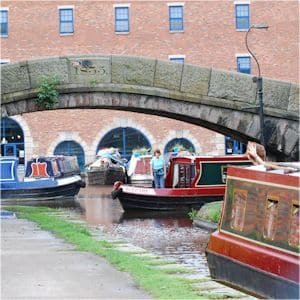Buying a new or used canal boat
Buying any canal boat is a major financial decision. An early choice you have to make to make is whether to buy a new or used boat. Cost may be the deciding factor, especially if you have a restricted budget. New boats cost from about £1000 per foot, so a 50 foot craft will set you back at least £50,000. Second-hand boats of this size can be bought for £30,000 upwards.
There are a large variety of different canal boat layouts, levels of equipment and designs of boat. If you are a new boater you should do a lot of research first to find the one that suits you.
Brokerages are great places to compare boats, and marinas are good places to chat to owners and see what they like, and dislike, about their own boat!
Buying a new canal boat
Buying a new boat is a major investment and should be treated with appropriate care and caution. If buying from new, check the financial stability of the boatbuilder or broker before putting in your order. Also shop around and compare costs and warranties in the same way you would for any other goods or services. The Recreational Craft Directive (right) sets standards for professionally built craft.
Most canal boat builders specialise in all steel hulls with diesel engines to a variety of styles. Many have ‘off-the-shelf’ standard canal boat styles which usually allow for some interior customisation. This can keep costs and prices lower and reduce the normal wait time.
Some firms will build replicas to traditional styles such as working narrow boats, tugs, inspection launches, barges or Dutch barges. Many also offer fitting out and refitting services.
Boat builders may offer a range of completion, from only hull or hull and cabin ‘bare shells’ through ‘sailaways’ which have engines fitted, to ‘fully fitted’ and ready to cruise. Some buy-in shells and specialise in fitting out. See our Listing of Canal Boat Builders.
Prices of new boats depend on a number of factors including the size of the boat, materials used, quality and complexity of the fit-out. A simple 20 foot cruiser may start at under £30,000, a 70 foot narrowboat fully equipped to a high standard could cost well over £150,000.
Contracts for a new canal boat
When you agree an order ensure you have a secure contract. You should lay out exactly what you are getting for your money, make regular payments as work progresses rather than large advance payments and ensure that you have a documented procedure for dealing with disputes. Many builders use a British Marine Federation Standard Contract which details when money is to change hands and releases ownership of the boat in stages as the build progresses allowing possession of some of the completed work should the builder fail.
You could choose between a ‘bespoke’ boat built to your specification, or an ‘off the shelf’ design. Bespoke boats mean a lot of planning and waiting, you could be cruising your off the shelf new boat almost immediately.
Or you could buy a standard hull and have it fitted out to your design, or even fit it out yourself.
Many buyers engage a marine surveyor to oversee the design and construction process and to ensure the boat has been built to the required specification. See our information box (right) and Listing of Marine Surveyors.
Buying a used canal boat
Brokerages and online sellers – register with a few to enable you to compare prices and alert you to anything coming up for sale that meets your criteria.
BSS – All used boats over 4 years old should have a Boat Safety Certificate (see information box right).
Hull – check it’s been made by a reputable builder and that it meets the traditional 10/6/4mm plating or steel thickness specification; 10mm is the thickness of steel used on the bottom of the hull, 6mm is the sides and 4mm is the roof.
General maintenance – does the boat’s general condition show it’s been well-looked after? What condition is the engine and gearbox in? Are there any leaks or drips from the stern gear? If there are, it may need repacking or adjusting.
Engines – Newer boats tend to be fitted with water-cooled diesel engines, whilst older craft carry noisier air-cooled engines or vintage models. Vintage engines are common on boats over 40 foot.
Condition – Check out the paintwork and varnishing and find out when it was last ‘blacked’ (taken into dry dock, pressure washed and had the hull protected with two coats of bitumen). And what about the onboard equipment, is the fridge, cooker, heating system and shower well-maintained and in good working order?
Batteries – three leisure batteries and one starter battery is usually the norm. Check if there’s a battery management system which regulates the flow of current into the batteries, resulting in greater efficiencies.
Inverter – you also need to ensure the boat has an inverter to convert 12 volt battery power to 240 volts. Without it, you’ll be unable to run electrical equipment such as a television or hair dryer, unless you’re plugging into a marina’s power supply.
All materials and images © Canal Junction Ltd. Dalton House, 35 Chester St, Wrexham LL13 8AH. No unauthorised reproduction.
About | Terms | Privacy| Refunds & Returns| Sitemap | Contact Us
With over 800 pages, this website uses cookies to record visitor behaviour using Google Analytics. More information on Privacy Page. Page last updated: 01/04/2025.





Back to Menu....
Canal Boat Buyers Guide >>
Boatowners Advice >>
Boat Owners >>